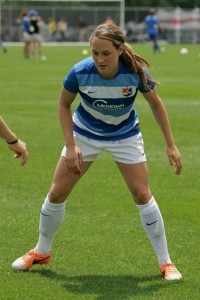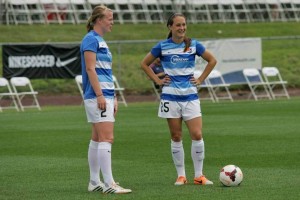
Maddie Thompson, a professional soccer player in the two-year-old National Women’s Soccer League, plays for Sky Blue FC in New Jersey. She gets paid $6,000 for playing a six-month season and when extrapolated over a 12-month period, Thompson earns only slightly more than what is considered the poverty level in the United States.
For Thompson, this means living frugally to play the game she loves. From March through August, she lives with a host family, sharing a bedroom and bathroom with one of her teammates, Kendall Johnson.
“It’s like a hotel room, except a little bit smaller,” Thompson said. They share a closet, but half of it is filled with the host family’s items. Thompson and Johnson buy their own groceries and cook their own meals rather than eat out. They also share a Ford Focus provided by the team. But, they have to pay for their own gas. Practice is 30 minutes away and the game field is 45 minutes away. “It’s also hard to plan around each other’s schedule,” Johnson said.
In the past dozen years, there have been two attempts at a U.S. women’s professional soccer league. The Women’s United Soccer Association started in 1999, riding off the Women’s World Cup high after the U.S. claimed gold. The second league, Women’s Professional Soccer, started in 2009. Both leagues folded after three seasons.
“The WUSA and WPS went a little big on salaries and the way we traveled,” said Christie Rampone, 38, captain of the U.S. women’s soccer team. She also is a 17-year national team member and played in all three leagues. “We lost a lot of money quick.”
In 2013, the NWSL was launched with a more conservative business plan.
“With women’s sports, whenever you are going to start something new, while there were two leagues before us, those that want to be part of this journey are going to have to take a little bit of a step back,” Cheryl Bailey, NWSL executive director, said in an interview with NBC Sports.
To help the new league endure, the U.S., Canadian and Mexican soccer federations have agreed to subsidize their national team players allocated to each of the NWSL teams. A $200,000 team salary cap is divided among the remaining players with salaries ranging from $6,000 to $30,000.
Without a cap in the past, teams would pay world-class players such as Brazil’s Marta $500,000 a season. Two out of the three American professional teams Marta played for folded. Although the NWSL can’t afford to draw top international players to raise the quality of play, this leaves an opportunity for American players. Many young players make up the 180-player league.
“The play is mixed a little bit,” Rampone said of the NWSL talent. “There are ups and downs. We’re missing some of the big names. But it’s actually helping sustain the league right now. We’re in a good place.”
Another priority for the NWSL is increasing its fan base. Nine clubs were chosen and each are in major cities — except for Los Angeles — including the Boston Breakers, Chicago Red Stars, Houston Dash, FC Kansas City, Portland Thorns, Seattle Reign, FC Sky Blue in New Jersey, Western New York Flash and Washington D.C. Spirit. According to Equalizer Soccer, a news site dedicated to women’s professional soccer, last season’s average attendance was 4,271. Most of the fans are families with girls who play soccer. “Demographic-wise … we can’t just have 12-year-old girls,” Sky Blue assistant coach Jay Cooney said. With limited marketing budgets, drawing a wider crowd has been challenging.

Thompson, 23, a recent Stanford graduate, joined Sky Blue in the NWSL’s inaugural season. She signed a one-year contract with a team option. If the team acts upon the extension, they will give her an automatic 10-percent raise the next season.
“It’s hard to save for the future,” Thompson said. She has to rely on her parents for financial support. “Not only do we work for only six months, but not a lot of people are making a substantial amount of money. It can’t carry over.”
Many players have second jobs to subsidize their six-month soccer salaries. Johnson coaches private lessons for youth girl soccer players. But even this is challenging as there is no set practice schedule, her transportation is limiting and Sky Blue travels often.
“It’s always in the back of my mind if it would be worth it,” Thompson said, of spending money on things other than basic essentials. Thompson is the only player on her team with a second job year-round outside of the soccer world. She is an East Coast representative for her family friends’ farm, Stahlbush Island Farms. It is an environmentally friendly farm and food processor located in her hometown in Oregon. “It’s super flexible,” Thompson said. She is able to get in six hours a week.
The league’s tight budget puts teams in obscure venues away from population hubs. Some are turf football fields as opposed to preferred soccer-specific grass fields. Sky Blue plays in central New Jersey at Rutgers University — “in the middle of nowhere,” Thompson said. The team takes seven-hour bus trips or early morning flights the day before a game instead of traveling early to adjust to the new time zones. “It doesn’t fully feel necessarily professional in the sense that we don’t have resources the way I see other men’s professional teams have,” Johnson said. In fact, some players are “taking a step down from their college facilities,” Rampone said. “It’s something you have to be professional about as a player and do the best you can.”
For many, the second year is crucial. Players will decide to continue to play for the low salary or pursue another career. “You don’t want to lose players like Maddie and Kendall because of the low salary,” Rampone said. “This [Maddie and Kendall] is sustainability.”
“In year three, you start to lose players,” Rampone said. “The first year, you have your rookie year and the second year you’re still digesting it all in. But, in the third year, it’s more of a decision-taking time.”
In the off-season, Rampone suggested the players who aren’t playing year-round with a national team to continue working for their teams off the field. The NWSL uses free marketing tools such as social media, but many people still don’t know about the league. With the exception of the Portland and Houston teams, which have the support of their Major League Soccer teams, there is low attendance. The Portland Thorns draws more than 13,000 fans per game while the Chicago Red Stars draws less than 2,000.
“You’ve got to do a little thinking outside the box,” Rampone said. “They can brainstorm throughout the off-season of how to draw more fans and get the name out there. It’s a win-win situation.”
Thompson is hopeful and willing to make the financial sacrifices to see the league succeed. “I really do think that this league will work and I hope it can be a foundation for women in sports,” she said. “It would be cool to be a part of that.”
“It’s the only time in my life my body can do it. It’s kind of a ‘why not’ situation,” Thompson said.
“These are the pioneers of putting in time and effort while getting little money,” Rampone said. “These girls are not playing for paychecks, but playing for the love and passion for it.”
